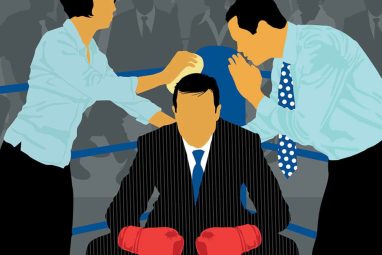How to Develop Continuous Learners
Leaders can help more employees upskill, reskill, and adapt to change by applying four key strategies.
News
- UAE’s AI Ambitions Collide With Infrastructure Limits, Kyndryl Report Warns
- India Accelerator Rolls Out $15 Mn Fund for Saudi Market Expansion
- OpenAI Raises the Bar for Enterprise AI with GPT-5.2
- OpenAI Flags ‘High’ Cyber Risk as State AGs Warn Industry Over Harmful Chatbot Outputs
- Riyadh Air, IBM partner to Launch World's First AI-Native Airline
- Adobe Leans Into AI to Defend Its Creative Tech Lead in 2026

Carolyn Geason-Beissel/MIT SMR | Getty Images
Amid the ever-increasing frequency and complexity of job changes and career transitions people experience, the notion of “one life, one career” has given rise to the phenomenon of a “portfolio career” that comprises a variety of roles. Education is also expected to shift from front-end loading early in life to continuous development throughout one’s work life.
Acquiring and developing new skills has never been more important than it is today, when organizations are quickly adapting in response to disruptive forces in geopolitics, climate change, and technology. The World Economic Forum estimates that 44% of core skills will change by 2027, necessitating widespread upskilling and reskilling. Similarly, PwC research shows that 79% of CEOs globally are concerned that skills shortages will hinder their company’s growth.
Despite the compelling pressure to engage in continuous learning, employees face formidable challenges in finding time and energy to pursue it. This results in inconsistent skill development that can be likened to a train that constantly sputters and halts. With an overwhelming laundry list of skills to develop — AI tools, data analytics, strategic thinking and leadership, and more — many employees are also unsure about which new skills they should prioritize. It also takes courage to explore new domains — to be naked in our ignorance as we start anew as beginners.
Developing Learning Agility
Learning agility is a process-oriented methodology rather than a content-focused learning skill like mind mapping or other memorization techniques. As we operate in increasingly uncertain times with no precedents, reliable formulas, or standard operating procedures, the ability to steer how we learn becomes critical in guiding us to find answers in novel situations.
Based on our research on learning agility, which included qualitative interviews with 24 career switchers and quantitative analyses of survey data from 340 professionals, we’ve identified the four elements that matter most in developing learning agility: linking purpose to learning, creating a learning-rich work environment, asking meta-learning questions, and nurturing a learning team.
Linking Purpose to Learning
Without motivation, there’s no battery power for learning. Our regression analyses showed that having a sense of purpose for learning predicts the successful development of skills and capabilities. The sense that what we learn will make a difference motivates us to prioritize learning — and managers can link learning any new skill to an employee’s sense of purpose.
A tax specialist who grew to assume a leadership role in a cross-governmental organization shared, “It’s about the significance and making a difference. The overriding motivation to contribute drives me to learn.” Feeling a sense of purpose overrides our fear of being ignorant in a new area.
Linda, an IT leader we interviewed, described a conversation she had with a cloud specialist, Bill, who seemed to be dragging his feet in his new role as a project lead, a position that had fallen into his lap with a recent restructuring. Linda asked, “What is important for you in your work? What gives you a high?” Bill paused. He considered himself a technical specialist rather than a people person. “I love it when what we create makes an impact — seeing people using the products,” he said. Linda asked, “In your role as a project manager, what skills do you want to sharpen so that your team can create products that make an impact?” Bill then realized that project and stakeholder management, in addition to technical skills, were keys for him to achieve his purpose.
Creating a Learning-Rich Work Environment
Creating a learning-rich work environment is the most critical workplace factor in fostering agility in skill acquisition, and it’s the second-most-important predictor of skill development, after purpose. A learning-rich job is defined as having work or diverse tasks out of one’s comfort zone that requires the application of new skills in different domains to succeed. For example, learning-rich jobs can involve a new role or challenging projects, learning beyond one’s function, leading or driving change, or taking on an expanded role.
Here’s a real example from our interviews. Cynthia laughed as she recounted how — “totally inexperienced” — she landed a job as an account executive. “My boss said that I didn’t even know how to turn on a computer and gave me three months to crack this job. If I can do it, it’s mine; if not, I’m out.” Cynthia had a lot to pick up — understanding how the industry worked, what the clients and her superiors wanted, and how to pull the information together to fulfill her role. She was motivated and resourceful in her learning process: digging into files to learn the organization’s history with clients, asking her colleagues beginner questions, observing her boss at work, enlisting mentors, and reflecting on her learning. Today, 22 years later, she’s the president of the company.
Drawing on business strategies and projects to create learning-rich opportunities, managers can extend employees’ development through experiments, projects, milestones, or assignments based on adjacent skills and complementary domains. For example, an IT professional was transferred from an HR analytics project to deliver the talent platform and people analytics dashboard, requiring her to use her IT skills in an HR context and learn a new domain. Similarly, an administrator was tasked with automating a repetitive workflow and needed to learn AI tools to do so.
Asking Meta-Learning Questions
The ability to reflect on one’s own learning process goes beyond learning techniques like mind mapping or heuristics; it’s about refining the way we approach growth. Meta-learning is the ability to stand back and think about what we want to learn, how to learn, the strengths and gaps in our learning process, and how to improve our learning.
For example, Lyn, a task-oriented managing director, wanted to scale her impact as a leader. She wanted her team to solve their own problems rather than solve problems for them. Shifting from her well-developed strength as a super problem solver, she learned coaching skills and how to ask questions instead of offering solutions.
Lyn asked herself the following meta-learning questions at different stages of her development journey:
- What is the skill I need to learn in this situation?
- How do I pick up this skill?
- Who can support me?
- How am I doing in developing this skill?
- What do I need to do now to be more effective in developing this skill?
- How do I know I am improving? Who can give me feedback?
- Who is a role model in this skill? How can I learn from them?
We found that this meta-learning reflection happens subconsciously and is often intertwined with reflection about what someone is learning. Managers can help their team members by asking these meta-learning questions, thus helping those individuals become more aware about how they learn. This allows managers to more intentionally accelerate the process with highly effective learning activities.
In addition, managers can guide their employees’ learning process as an ongoing practice by doing the following:
- Suggesting various stimuli, such as attending a workshop, reading a book, or listening to an expert lecture.
- Reflecting on how the lessons connect with their work experience.
- Identifying when and where they can use these new ideas.
- Determining from whom and how can they get feedback.
A system of stimuli, reflection, application, and feedback forms a continuous learning process to accelerate learning.
Nurturing a Learning Team
Being in a diverse team to exchange resources readily and give and receive prompt feedback makes learning a fun and powerful norm. One researcher spoke affectionately about her team: “Diversity gives me so much to observe and learn with genuine and generous bidirectional feedback.” Critical feedback is welcomed as colleagues constructively challenge one another and exchange relevant articles and resources.
Managers can foster development-focused teams through regular routines. For example, they can support an employee in making it a weekly priority to learn something that will help them in their current work, such as reading a book, learning how to use a new AI tool, or attending a talk. Teams can allocate 15 to 30 minutes in regular meetings for everyone to share their learning periodically. Leaders can also model an appreciation for feedback, such as by asking everyone to give and receive feedback once a month — sharing one thing they appreciate about a team member and one suggestion for improvement. Assigning the team a learning-rich task, such as automating business processes, brings everyone together to learn new tools or skills.
To develop agile learners on their teams, managers can facilitate a synergistic spiral of learning by linking employees’ purpose to their learning, creating a learning-rich work environment, asking meta-learning questions, and nurturing a learning team. These elements provide a framework for unlocking the potential of learning agility. In doing so, managers not only help their people pick up new skills easily but also build an agile, high-performing team to navigate and thrive in a rapidly changing landscape.
The true power of learning agility lies in its compounding effect: As individuals continuously adapt and learn, they grow not only in knowledge but also in their ability to handle ambiguity, complexity, and change. This adaptability becomes a competitive advantage for organizations, fostering a culture in which learning is not just an event but an ongoing process. When teams cultivate these habits, they don’t just respond to disruption — they become drivers of innovation who will be able to lead their organizations into the future.





